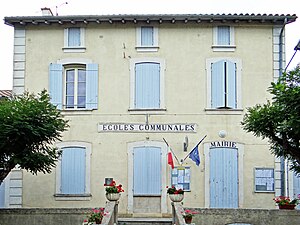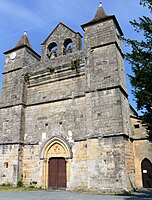Montagnac-sur-Lède
| Montagnac-sur-Lède | ||
|---|---|---|
|
|
||
| region | Nouvelle-Aquitaine | |
| Department | Lot-et-Garonne | |
| Arrondissement | Villeneuve-sur-Lot | |
| Canton | Le Haut Agenais Périgord | |
| Community association | Bastides en Haut Agenais Périgord | |
| Coordinates | 44 ° 33 ' N , 0 ° 51' E | |
| height | 85-231 m | |
| surface | 19.55 km 2 | |
| Residents | 273 (January 1, 2017) | |
| Population density | 14 inhabitants / km 2 | |
| Post Code | 47150 | |
| INSEE code | 47181 | |
 Mairie (Mayor's Office) |
||
Montagnac-sur-Lède is a French municipality with 273 inhabitants (at January 1, 2017) in the department of Lot-et-Garonne in the region Nouvelle-Aquitaine (before 2016: Aquitaine ). The municipality belongs to the arrondissement of Villeneuve-sur-Lot and the canton of Le Haut Agenais Périgord (until 2015: canton of Monflanquin ).
The name of the municipality goes back to the Roman name Montagnus .
The inhabitants are called Montagnacais and Montagnacaises .
geography
Montagnac-sur-Lède is located about 20 kilometers northeast of Villeneuve-sur-Lot in the historic province of Agenais on the northeastern edge of the department.
Montagnac-sur-Lède is surrounded by the six neighboring municipalities:
| Paulhiac | Gavaudun | |
| Monflanquin |

|
Salles |
| Lacaussade | Monségur |
Montagnac-sur-Lède is located in the catchment area of the Garonne River in the Lède valley , a tributary of the Lot .
They and their tributaries cross the territory of the municipality,
- the Ruisseau de Lazaygues and
- the Leyze with its tributaries,
- the Ruisseau de Bègues and
- the Ruisseau de Labriane, which rises in Montagnac-sur-Lède.
history
The community has received almost nothing of the medieval townscape. Due to the strategic location at an altitude of 230 meters, it is likely that there must have been a fortification there, as in many places in the Agenais, given the clashes during the Hundred Years War .
Population development
After records began, the number of inhabitants rose to a high of around 995 by the first half of the 19th century. In the period that followed, the size of the community decreased until recently, with short periods of recovery.
| year | 1962 | 1968 | 1975 | 1982 | 1990 | 1999 | 2006 | 2011 | 2017 |
|---|---|---|---|---|---|---|---|---|---|
| Residents | 362 | 335 | 284 | 290 | 259 | 267 | 262 | 249 | 273 |
Attractions
Parish Church of Saint Martin
The Saisimentum , a document of an oath of office, which in this case concerned the Bailliage of Monflanquin, mentions a building called "Parrochiade Montanhaco". The first church was built between the 12th and 13th centuries. Only the semicircular apse remains from this original structure . Their buttresses were added at a later date. Five windows give light to the choir , which are framed inside with nine arcades that rest on columns . The capitals show ornaments in the form of leaves standing in a row. The abacuses are decorated with pearls. The arches rest on consoles with protruding sculptures in the form of heads. The west facade is flanked by two towers that are connected by an overhanging transition. A small bell gable rises behind it . The church suffered great damage during the Huguenot Wars . During the restoration in the 19th century, the roof was raised by one meter, the nave was provided with a ribbed vault , three side chapels were built on the south side and six windows were created in the nave.
The church has been registered as a Monument historique since January 7, 1926 and invites, among other things, to regular concerts.
Three items of equipment in the church are inscribed as a monument historique of movable property. It is a sculpture depicting Saint Philomena of Rome from the 19th century, a baptismal font from 1642 and a plaque from 1514 on the occasion of the construction of a chapel.
Mill Le Cros
It was mentioned in 1644 in a pamphlet expressing the gratitude of a farmer in the village to Louis de Fumel who gave him a piece of land. Until the end of the 18th century, the company owned an oil mill and a pair of stones for grinding grain. In the 18th century, the nobleman de Saint Paul had a mansion built 150 meters from the mill. After the Seigneur von Paulhiac disappeared, the family became the owners of the mill. In 1789, the de Saint Paul family was driven out by insurgent farmers. In 1833 the residents of the manor house no longer had the means to maintain the mill and gave their property to the Garrigous, an old milling family. Around 1850 a bakery was added after a baker married into the family. In 1893 there was a big fire. In 1913 a modern flour mill was installed and the mechanical mill was taken out of service. In 1960 the processing of grain was stopped, but the bakery continued to operate. The oven has been modernized. Diversification is needed in the late 1980s as the rural population ages and the number of farms declines. In 1989 the old watermill was reactivated. In 2006 the baker retired and the mill continued to operate as a museum bakery.
Economy and Infrastructure
Agriculture is the municipality's most important economic factor. The community is also trying to expand tourism.

total = 46
education
The municipality has a public primary school with 27 pupils in the 2018/2019 school year
traffic
Montagnac-sur-Lède can be reached via Routes départementales 150, 221 and 417.
Web links
- Website of the museum bakery (French)
Individual evidence
- ↑ a b c d Montagnac-sur-Lède ( fr ) Conseil régional d'Aquitaine. Archived from the original on September 13, 2016. Retrieved March 23, 2019.
- ↑ Ma commune: Montagnac-sur-Lède ( fr ) Système d'Information sur l'Eau du Bassin Adour Garonne. Retrieved March 25, 2019.
- ^ Notice Communale Montagnac-sur-Lède ( fr ) École des Hautes Études en Sciences Sociales. Archived from the original on March 4, 2016. Retrieved March 25, 2019.
- ↑ Populations légales 2016 Commune de Montagnac-sur-Lède (47181) ( fr ) INSEE . Retrieved March 25, 2019.
- ^ Eglise Saint-Martin ( fr ) French Ministry of Culture . September 22, 2015. Accessed March 25, 2019.
- ^ Eglise Saint-Martin ( fr ) Conseil régional d'Aquitaine. Archived from the original on March 3, 2016. Retrieved March 23, 2019.
- ^ Sculpture: Ste Philomène ( fr ) French Ministry of Culture . December 30, 2015. Accessed March 25, 2019.
- ^ Fonts baptismaux ( fr ) French Ministry of Culture . December 30, 2015. Accessed March 25, 2019.
- ↑ plaque commémorative de la construction d'une chapelle ( fr ) French Ministry of Culture . October 7, 1993. Retrieved March 25, 2019.
- ↑ Historique du Moulin du Cros ( fr ) Musée du Moulin du Cros. Retrieved December 13, 2019.
- ↑ Caractéristiques des établissements en 2015 Commune de Montagnac-sur-Lède (47181) ( fr ) INSEE . Retrieved March 25, 2019.
- ^ École élémentaire ( fr ) National Ministry of Education. Retrieved March 25, 2019.



